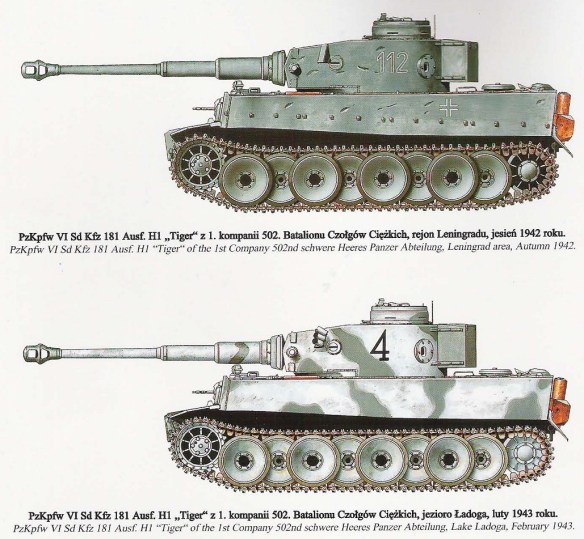Heavy Tank Company, K.St.N. 1176d Dated 15 August 1942.
Heavy Tank Battalion, Organization D, 1942-43.
While the Army ordnance department was developing the heavy tank, the Army General Staff made plans to field heavy tank companies when production began. Initially, the plan for the heavy tank company included three platoons, each with three Tigers, for a company total of nine heavy tanks. Until the spring of 1942, this plan included the heavy tank companies in the current panzer regiment organization within panzer divisions, although a formal change to the organization was not made.
After the automotive design office of the Army ordnance department finalized the Tiger and estimated production figures, the Army General Staff realized that the Tiger could never be produced in sufficient quantity to replace the Panzer IV on a one-for-one basis. The new tank also lacked the tactical mobility to be included in the panzer divisions. It was difficult to find a suitable place for the Tiger in the panzer divisions, and as a scarce resource, the Army General Staff decided to consolidate the available Tigers in independent heavy tank battalions and employ them where they were needed most. They thought that in so doing, they could be most economically employed directly under the command of an army or corps headquarters.
On 16 February 1942, the Army General Staff created the first two heavy tank companies and subsequently assigned them to the Heavy Tank Battalion 501. The first three heavy tank battalions, Heavy Tank Battalions 501, 502, and 503, were created in May 1942. These units organized themselves based upon the contemporary wartime organizational table (in German, die Kriegsstärkenachweisung, or K. St. N.). This table called for nine heavy tanks per company, consisting of three platoons with three tanks each. The heavy tank battalions received new guidance via an Army bulletin on 21 August 1942 to organize along the lines set forth in a new table of organization (T/O). The new heavy tank companies organized themselves in accordance with T/O 1176d, dated 15 August 1942. This company organization was known as “Heavy Tank Company D” (hereafter referred to as the Company Organization D). The primary difference between this organization and previous heavy tank companies was that this organization authorized a mix of heavy and light tanks, with Tigers and Panzer IIIs-which were then the standard German medium tank-being integrated within each platoon of the company.
This version of the heavy tank company lasted until the General Staff published a new T/O in May 1943. By that time, the German Army had equipped and fielded five heavy tank battalions, with Heavy Tank Battalions 504 and 505 being created in December 1942 and January 1943, respectively.
The leaders of these battalions experimented and used almost every variation of Company Organization D. Some companies changed their organization internally to form two light and two heavy platoons. Sometimes, commanders organized their platoons so that each possessed a light section and a heavy section, while some had their sections within platoons integrated with a Panzer III and a Tiger.
These internal reorganizations focused on finding the best combination and organization to accomplish the missions assigned. All echelons of command granted great latitude to experiment to find a combination of vehicles that worked best. Occasionally, some companies within the same battalion and some platoons within the same company were organized differently.
The purpose of mixing platoons and sections with Panzer IIIs and Tigers was for the medium tanks to provide the heavy tanks with close support against infantry and assist in destroying antitank guns threatening the Tigers.” The T/O did not specify which model of Panzer III was authorized for the heavy tank companies.
The heavy tank battalion was authorized three heavy tank companies, but because of a shortage of Tigers, no battalion ever fielded a third company of the Company Organization D in combat. A headquarters company and a maintenance company, along with the two heavy tank companies, completed the total organizational structure of the heavy tank battalion. The headquarters company was organized in accordance with T/O 1150d, dated 15 August 1942, thus keeping the “D” designation to the overall heavy tank battalion organization.
The battalion “light platoon” was subordinated to the headquarters company, but presumably worked directly for the battalion commander during combat. The T/O for these platoons also failed to specify which model of Panzer III was authorized. This platoon could be used to reinforce the tank companies against infantry attacks or could be used to screen the battalion’s flank.
The focus on finding a mixture of vehicles and an organization that worked best seems to have continued at the battalion level when using the light platoon. Three of the first four battalions fielded, namely Heavy Tank Battalions 501, 502, and 504, retained the light platoon under the control of the battalion as it was originally intended. Heavy Tank Battalion 503 formed a battalion light platoon consisting of five Panzer IIIs. The remainder of Heavy Tank Battalion 503’s Panzer IIIs were allocated to the heavy tank companies, allowing each company to form a “heavy” platoon of three Tigers and one Panzer III, as well as a light platoon.
The first five battalions created were fielded under the Battalion Organization D. These battalions fought in Tunisia against British and American forces, as well as in the Caucasus and in the vicinity of Leningrad against Soviet forces. These units’ after-action reports indicated that the mix of medium and heavy tanks allowed these battalions a higher degree of flexibility. These reports also stated that the Panzer III did not have sufficient armor to conduct offensive missions against prepared defensive positions with the Tiger.
